Nerdcation 2011: Mr. President
Back in my carefree bachelor days I visited whatever I wanted. Two presidential sites in a day? Why not THREE? But in August 2010 Igot married, and my wife is lucid, so it's not realistic to expect her to go on history benders with me. Fortunately she's an understanding woman who also appreciates the virtues of not spending every waking moment with me. So here's the itnerary of Nerdcation 2011, which took place in September:
- Thursday: Fly to Louisville. Get rental car. Drive immediately to the grave of Zachary Taylor. Think about how much Zachary Taylor means to the nation, for no more than 15 minutes. Drive 90 minutes west to Lincoln Boyhood National Memorial. Question the value of "living history" displays. Drive 90 more minutes to Grouseland, the home of William Henry Harrison.
- Friday: Get to Springfield. Visit the Lincoln home and tomb. Visit the Lincoln library. Go to the recreation of New Salem, Lincoln's old town.
- Saturday: Get to St. Louis. Visit the U.S. Grant home. See something else, like the Gateway Arch or the beer factory or the City Museum.
- Sunday: See Grant's Farm in the morning. Go to the last Cardinals home game of the year in the early afternoon. Fly home Sunday night.
If you're keeping score at home, that's seven presidential sites, covering two Whigs and two Republicans, over the course of four days. Plus a baseball game. The moral is: go for the gusto. Here are the notes I wrote at the time.
September 22, 2011
Hello from beautiful Springfield! I'm assuming it's beautiful, because I got here at night and checked into a Motel 6, after buying peanut butter and bread at a Circle K staffed by, and mostly catering to, people who appear to be on meth. (Or whatever meth-like substance they've managed to make at home. Midwesterners are resourceful, hard-working people -- even the meth heads.) But some very promising brochures I procured in the lobby suggest that this place is a total gas in the daylight.
But Springfield is tomorrow's story. Right now, you probably want to hear about the Opening Day for Nerdcation 2011. If you missed my earlier postings, this is a trip I am undertaking by myself, in which I will see 9 presidential sites and a baseball game in four days. I am doing it by myself for two reasons:
1) It allows me to move at a breakneck pace that inexpert historical tourists would find near-fatal.
2) No one really wanted to come with me.
But mostly No. 1. I flew from Baltimore to Louisville this morning, got a rental car, then saw Zachary Taylor's grave, Lincoln's boyhood home, and W.H. Harrison's territorial mansion. I wrapped up by driving 3 hours to Springfield. More details in a second, but first some general observations, to establish my street cred as a Charles Kurault figure:
- For some reason, half the towns in this part of the country are named after foreign countries or cities. Today I drove through both Ireland and Paris, and in the past I have been through Peru and Moscow. There is a reason for this: going back to the 18th century, even the settlers who moved to Indiana, dreamed of being anywhere other than Indiana.
- Illinois has a waterway called the Embarrass River. I don't know if you can go innertubing on the Embarrass, but I imagine that if you do, your mom comes with you and wears a two-piece.
- Both Indiana and Illinois have a penchant for putting up brown roadsigns that say "Historical Marker" and have an arrow indicating a turn. There is no mention of what is being marked, just that there's a historical marker. Sex it up, guys. Put a question mark on those signs. "Historical Marker?" -- that's a signpost I'm going to follow, to ADVENTURE.
- The St. Louis Cardinals lost 8-6 to the Mets after giving up six runs in the top of the ninth. I know this because the Cardinals are on 14 FM-band radio stations, even in Indiana. Also, Tony LaRussa makes so many pitching changes that I can now recite from memory the ads from the companies that "sponsor" each call to the bullpen.
- I'm pretty sure small-town economies are pretty much based on meth these days. This is a scientific observation based on me stopping at a Subway for dinner and watching the people pulling into the Walmart parking lot next door.
- For some reason I thought Wabash Cannonball was a pool player, like Minnesota Fats. Turns out it was a train. I feel pretty dumb about that, in retrospect.
Zach Attack
Zachary Taylor earned the monkier "Old Rough and Ready," not just for his slovenly appeal, but for an indifference to danger: he would join his men in the thick of battle, riding his horse and daring the enemy to take him out. In his illustrious 40-year career, he survived wars with the British, the Black Hawks, the Seminoles and the Mexicans.
But he lost the war with 19th-century produce. At a groundbreaking ceremony for the Washington Monument on an oppressively hot July 4, Z.T. chugged a pitcher of ice milk and chowed on some possibly tainted fruit. His bowels were rough, but not ready, and a few weeks later the meaty hand of Millard Fillmore was on the national tiller. As it turns out, death is just a bowl of cherries. HAH!
His body was shipped back home to Louisville and his family plantation, where (oddly enough) it has not enjoyed a very restful eternity. The original crypt was a tad on the plain side.
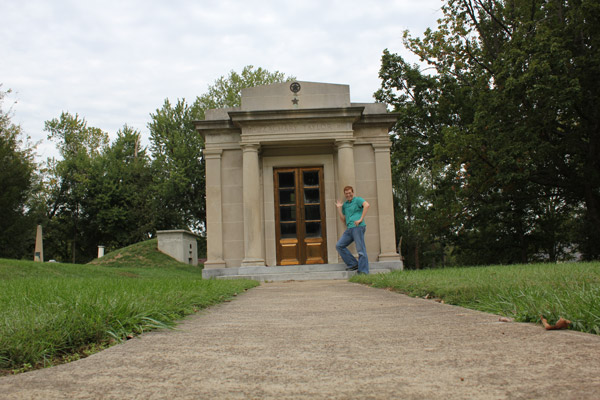
Zachary Taylor's final resting place ... for now.
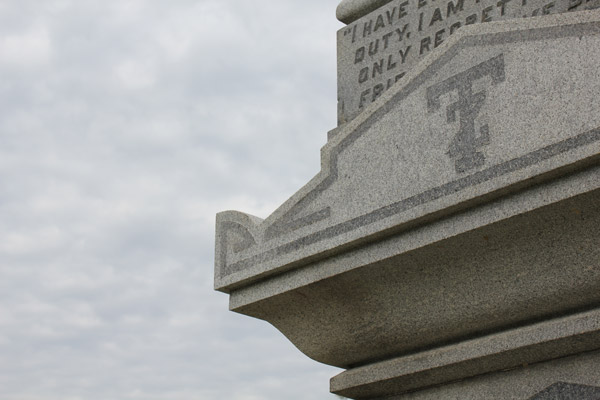
A detail of the Taylor monument, near the mausoleum.
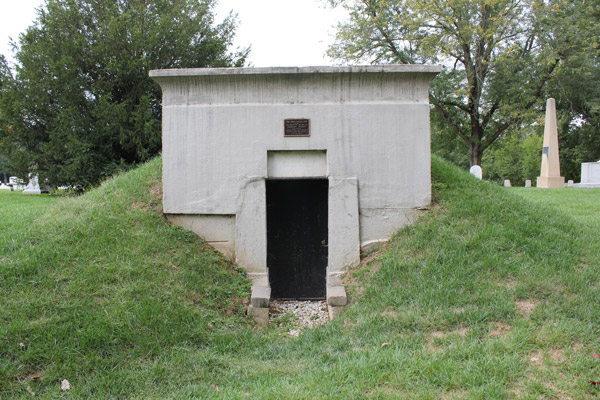
Taylor's original mausoleum, still standing for graveyard enthusiasts to enjoy.
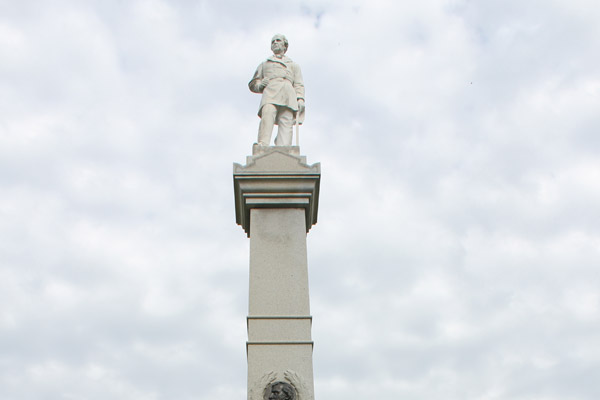
The top of the Taylor memorial. Zach-o, not on his back-o.
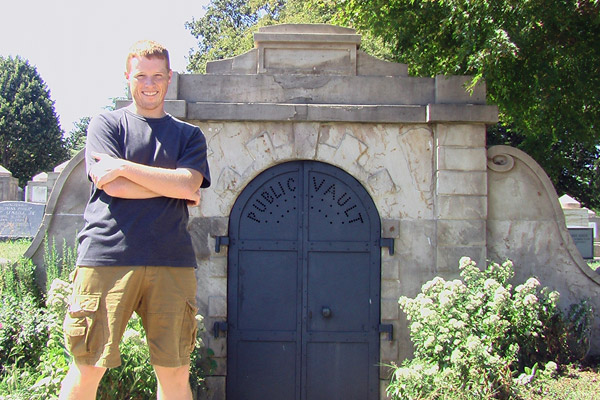
Congressional Cemetery: A bonus shot of the "public vault" in D.C.
Now, hillside construction is great. The Earth acts like a thermos, keeping your hots hot and your colds cold. But in the 1920s, someone decided to pimp his crypt. The old structure was (presumably) converted to a walk-in beer fridge to accommodate shaken mourners, and Taylor was moved a short distance to this fine mini-mausoleum. When I visited, the windows were sweating from all the moisture getting inside, and there were lots of wasp corpses visible on the floor of the interior, because they had clearly built a nest somewhere on the structure.
Now, you're probably thinking that his corpse has rested there ever since, peacefully slumbering as a mildew-covered nest for hornet larvae. But you'd be wrong! In the early 1990s, someone got the notion that maybe Taylor was poisoned, perhaps by the president of the Millard Fillmore fan club. So Taylor was yanked from his crypt. Samples were taken, no poison was found, and Taylor was put back on the shelf.
He's due for another disturbance around 2050. Every 70 years or so, it's good to air out your dead presidents, whether they need it or not. I have to say, I liked the grave. The surrounding land -- once part of the Taylor estate -- has been converted into a veterans cemetery, so the general is fittingly surrounded by troops. There's a nice monument (a statue on a column) a few yards from the crypt. But the cemetery is also a fine example of history colliding with the present. It's surrounded on all sides by suburban Louisville. Little girls were playing on a swingset about 100 feet away, and some people had a basketball hoop setup so close to the wall that anyone practicing half-court shots might bounce it off the mausoleum. Good luck getting your ball back.
The bummer here is that you can't visit the home. It's still standing, but it's owned by descendants, and those bastards refuse to turn over their ancestral mansion to accommodate my hobbies. Some people are so selfish.
One fun Taylor fact: he had a daughter who was born in Vincennes, Indiana (which I visited later in the day), and later married one of Taylor's military underlings. That guy was Jefferson Davis. She died a few months into the marriage, but Zachary Taylor's son in law was the president of the Confederacy. Huh.
Milk Sickness: It Does a Nation Good
Milk, so essential to the development of strong bones and health teeth, also developed the free world. By killing Nancy Hanks Lincoln.
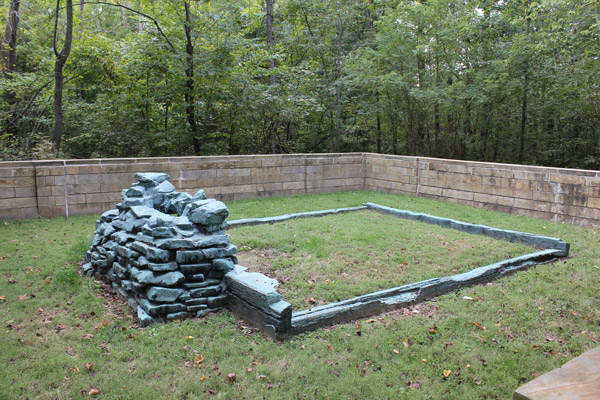
Great men have strong foundations.
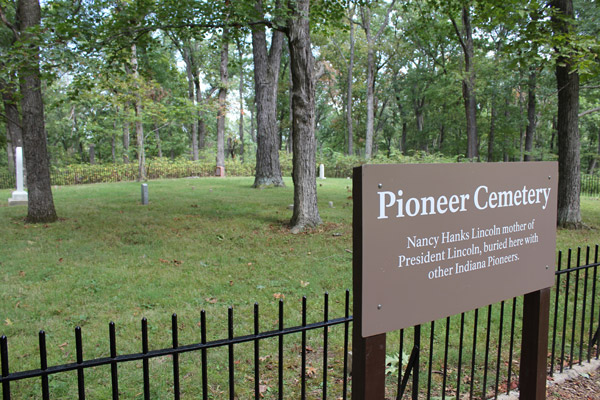
Nancy's final resting place.
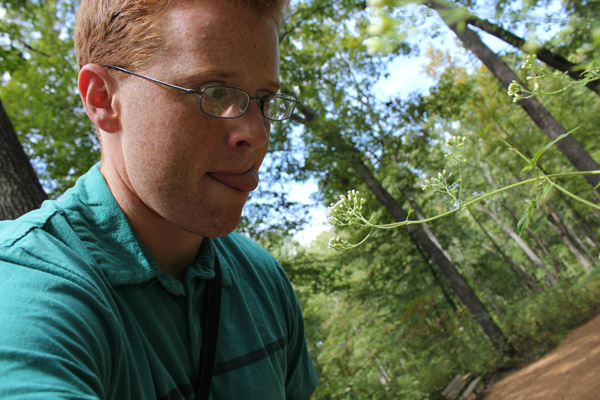
No one can resist sweet, delicious snake root.
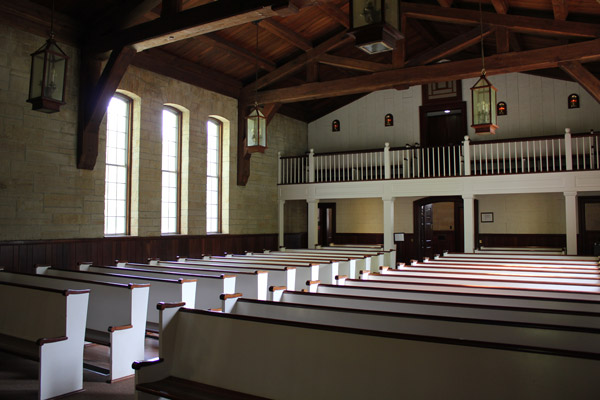
A nice memorial chapel where you can pray about Lincoln and stuff.
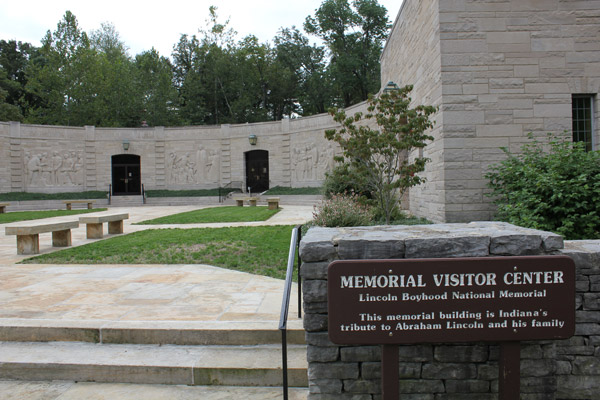
The visitors center for the monument.
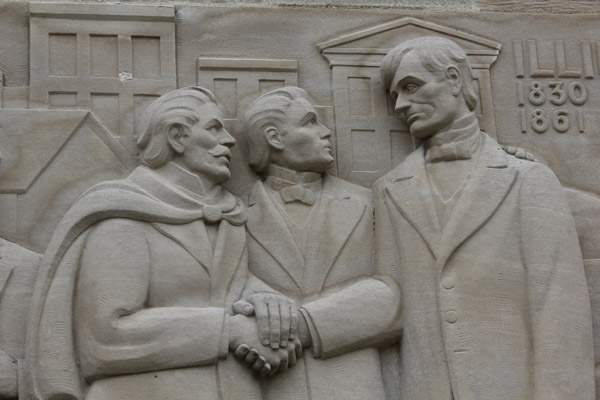
The famous meeting between Lincoln and Uncle Joe.
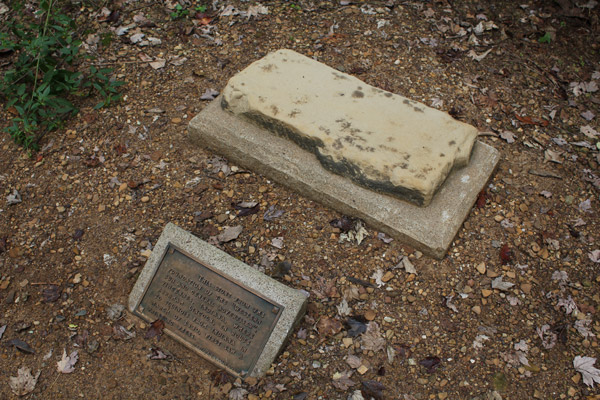
Behold the wonders of the TRAIL OF TWELVE STONES!
Sort of. What actually got her was snake root. Cows tended to eat it, which poisoned their milk. Modern medicine has made "milk sickness" a thing of the past, but in 1818 it was wiping out the milk-loving, god-fearing people of Southern Indiana. It killed Nancy, and the state of Indiana and the National Park Service now team up to honor her memory -- with a few acres of snake root.
Yummy! All this and more can be enjoyed at the Lincoln Boyhood National Monument, in scenic Lincoln City. It's a subdued site, but arguably an important one; the Lincolns moved there when Abe was 7, and he lived there until he was 21. His frontier upbringing started in Kentucky, but it blossomed in Indiana.
His mom's death shaped Abe's personality and thrust new responsibilities on his gawky shoulders. His stepmom entered the picture, his informal education continued, and he learned the value of hard work while toiling beside his father on a farm chopped out of the wilderness. Had Nancy Hanks been a lactard, the South might have won the war.
That's why Nancy's grave is probaby the main historical attraction of the site. Leaving the visitor's center, two colonnades of trees line a wide path cut in a hillside. An illumated flag pole sits at the top, and hidden in the trees just beyond that is the pioneer cemetery where Nancy is resting with the other people who got milk.
Walking farther, there's another path through the snake-root-infested woods. The trees are thick enough to give you that 1815 sense of isolation and wilderness, and there was a historical smell in the air: either snake root is disturbingly pungent, or I was downwind from a sewer backup.
When the trail ends, you're confronted with what's left of Thomas Lincoln's 300-acre farm.
It's a hole in the ground. The cabin, built by Abe and Thomas together, is long gone. They did find some evidence of the foundation and hearth, however, so the bronze cast was put in place to mark the site. There's also a "living history" farm operated under 1820s standards, but those things always suck, so I headed instead to the awesomely titled "Trail of Twelve Stones."
Sadly, it's false advertising. There were no riddles, feats of strength, booby traps or hidden speakers playing Iron Maiden hits. The trail just winds past 12 small rocks taken from various buildings important to Lincoln's life. But it does dump you back at the far more interesting stones on the vistors center. There are four friezes on the outside of the building, and each panel has an allegorical image representing a phase of Lincoln's life. Including the time that Lincoln met Josef Stalin.
Fort Harrison
A man's home is his castle. When building his governor's mansion in Vincennes, William Henry Harrison decided to take that literally.
- There are gun ports around the entire house at ground level.
- In a town of log structures, most walls were solid brick construction at least a foot thick.
- The window shutters were 2-inch-think slabs of wood capable of stopping bullets.
- There's a lookout tower in the attic and the walls facing the Wabash River are curved outward to improve the range of vision.
- The basement has an armory, a well and an old-school septic system (a French drain) to dispose of sewage in the event of a seige. There's enough floor space to sleep a bunch of townspeople in an emergency.
- He didn't rig a murder hole, but only because huge cauldrons of boiling pitch might damage the carpets.
With a home like that, a man could screw over some Indians! In the early 19th century, when Thomas Jefferson put him in charge of the vast Indiana Territory, Vincennes was a white raft floating on an ocean of wilderness. More settlers were on the way, and the feds wanted to secure any mildly dubious lands claims with the indigenous inhabitants.
Harrison had a flair for it. The Constitution didn't really anticipate the administration of federally held territories, and so governors could act like dictators as long as they got results. He would find sympathetic chiefs, then negotiate ridiculous land swaps that those chiefs weren't really authorized to make -- as the guide at Grouseland put it, it was like paying the mayor of Akron to sign over Ohio. Harrison also looked the other way whenever settlers got needlessly violent with the locals. Hostilities were a definite possibility, and Harrison probably had some personal bugaboos, too: his birthplace, the Berkley plantation in Virginia, was the site of pretty significant massacre of settlers in the 17th century. The home Harrison was born in had brick walls two feet thick, so at least the family was mellowing over the generations.
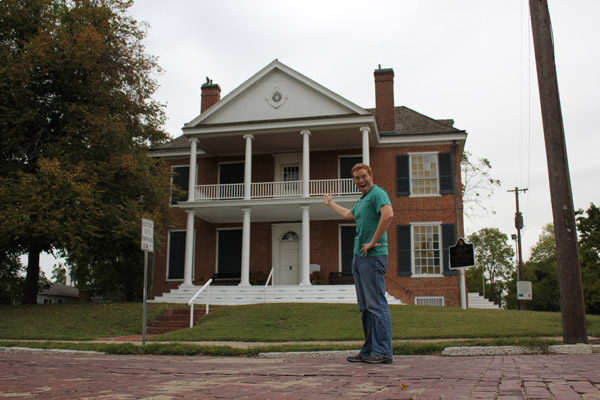
It's a fort! It's a house! It's two, two, two things in one!
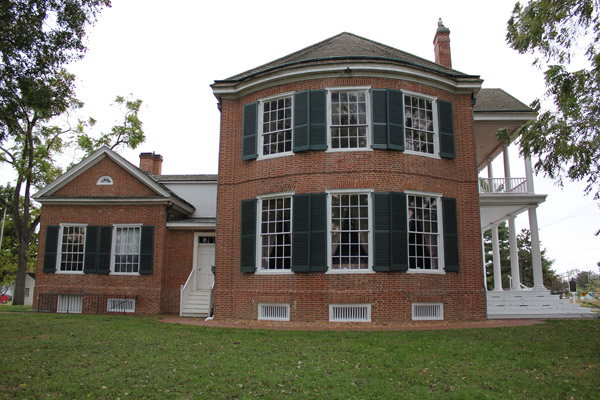
You can see the defensive elements, such as the basement gun ports and the curved walls.
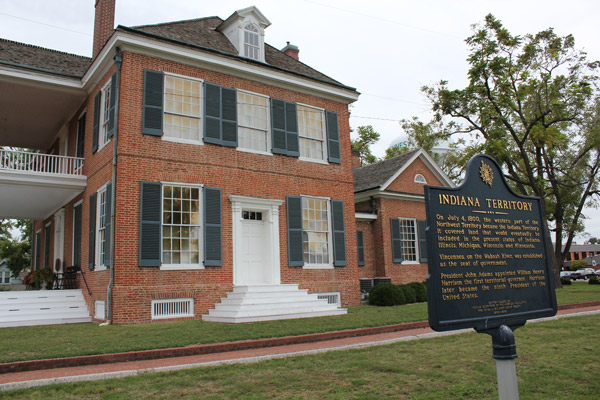
A very classy home, considering it was the middle of nowhere.
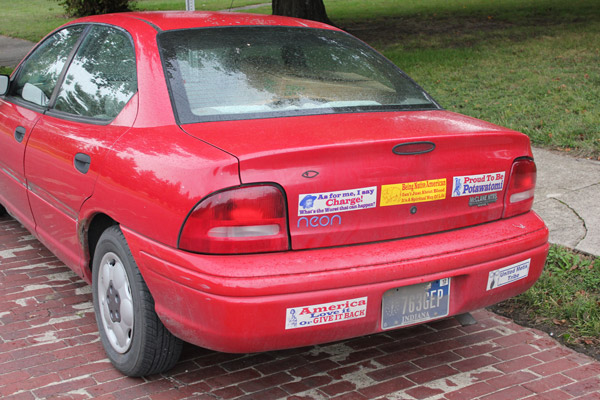
The many bumperstickers of my guide's car. I liked that guy a lot.
Which isn't to say that Grouseland has no charm. When he wasn't eradicating the legacy of an entire race, Harrison had a few dinner parties. The room where fairly significant chunks of the Midwest were snapped up also doubled as a swanky parlor for chatting up guests. Harrison had a reputation as a regular, approachable dude -- he dressed neatly, but not like a rich prig; he was happy to welcome regular Joes into his dining room; and he was famously beloved by his troops. One marker on the property said Grouseland was the birthplace of "Hoosier hospitality," which is really just Virginia plantation culture moved 600 miles west. The building has a frontier elegance about it, and since Harrison's wife was constantly popping out children, it's also homey.
But the Indian stuff is what makes it sexy. Grouseland is where Harrison laid the foudation for the legend of "Old Tippicanoe." He stepped on enough toes that eventually Tecumseh and the Prophet called shenanigans. There was a famous showdown at Grouseland, with Tecumseh getting into a shouting match with governor. And as the nearby settlement founded by the brothers started to grow, Harrison's paranoia got the best of him. He waited for a time when Tecumseh would be out of town, raised a militia and marched north to Tippicanoe to burn the Indian village. Classy.
Now, I ask a lot of questions on any given tour. But there are people -- middle-aged pudgy white men with woven belts, mostly -- who prefer to quote history lessons to the actual guides. This is because no one will talk to them about their hobby, they are not getting the graded validation of a classroom enviroment, and they haven't figured out that blogging is a good release. Such a man was on my particular tour, and on hearing this story, he lectured the guide for about 30 seconds before closing with, "You have to admit the Indians had it coming."
At that point, the tour guide admitted that he was half Indian. Specifically, the kind of Indian whose land Harrison stole. My enjoyment at belt guy's awkward reaction doesn't really justify three centuries of oppression and discrimination, but hey -- make as much lemonade as you can, right?
FUN GROUSELAND FACTS!
- There is some original furniture in the building, but many decorations aren't exactly accurate; the D.A.R. owns the house, and according to the guide, the little old ladies who decorated it went a little overboard. For example, it is highly unlikely that William Henry Harrison kept five tea sets and kitten-embroidered pillows on his bed.
- Tecumseh predicted the 1811 New Madrid earthquake to other tribes as a symbol of his power. The plaster in two of the Grouseland guest rooms still has cracks from that quake. SUCH WAS THE TERRIBLE WRATH OF TECUMSEH!
- Indiana was supposed to be free territory, but Harrison brought along slaves when he moved to Grouseland. When this caused concern among some human-rights-minded settlers, Harrison solved the problem by declaring his slaves to be honorary Indians.
- Harrison's hat and saber from Tippicanoe are on display at Grouseland. He eventually left the home for military service in the War of 1812, and had caretakers operate the building as a bed and breakfast for people who didn't mind the risk of being scalped in their sleep.
- The name of the house comes from the birds that were plentiful in Indiana at the time; grouse was one of Harrison's favorite meals. His grandson Benjamin Harrison took this to heart in naming his first home, Funnel Cake Junction.
- Despite Harrison's worries, there were never any Indian attacks on the building. However, 7 teenagers were shot trying to egg the house on Halloween 1808.
- Harrison wasn't a particulary brilliant military strategist, but as the father of 10 children, he did wage a very effective siege on his wife's uterus.
September 23, 2011
We pick up our exciting tale of adventure in Springfield. Our heroic traveler drove three hours from Indiana the night before, braving the terrors of rural Illinois to arrive at a Motel 6. By the end of the day he plans on reaching another Motel 6 in Saint Louis, and in between he will see lots of Lincoln-related crap, plus whatever else he stumbles across.
Springfield Has Sprung
The problem with Abe Lincoln is knowing where to begin. In life, he held together the Union; in death, he holds together the Illinois tourist economy. Some time ago, the state council of elders -- Richard Daley's poker buddies -- came up with the "Land of Lincoln" motto, and being Chicago poker players, they went all in. (You can do that when you cheat at poker.) Every object or surface he touched, fondled, stood upon or sneezed near is graced with a historical marker, or (if he sneezed twice) a state park.
Same goes with the literature: one sign I saw claimed that Lincoln is second only to Jesus is number of books written about his life. But with Jesus, you can always go with the best-seller and feel pretty good about your choice. In the case of Lincoln, you have to decide if you want his life interpreted through a lens of depression, a loving marriage, a hateful marriage, homosexuality, wit, religion, slavery, weakness, strength, co-workers, enemies, conspiracy theories, his children, his children's deaths, his parents, his parents' deaths, his work experience, his love of the theater, Marfan's syndrome, social status, Consitutional law, military savvy, military ineptitude, folklore or his decision to grow a beard. That last one is coloring book, but it has the virtue of being a quick read.
You have to start somewhere, though, so let's look at his house.
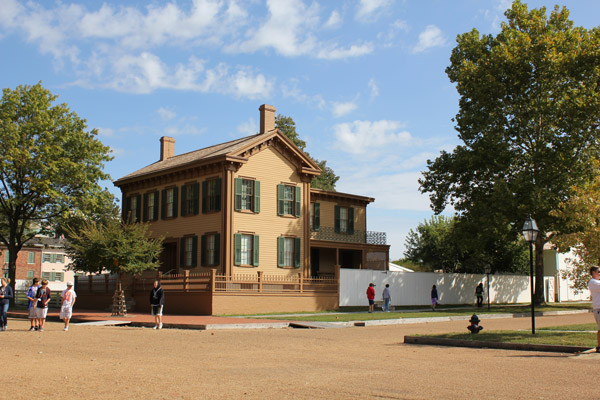
Upper-middle-class living at its finest.
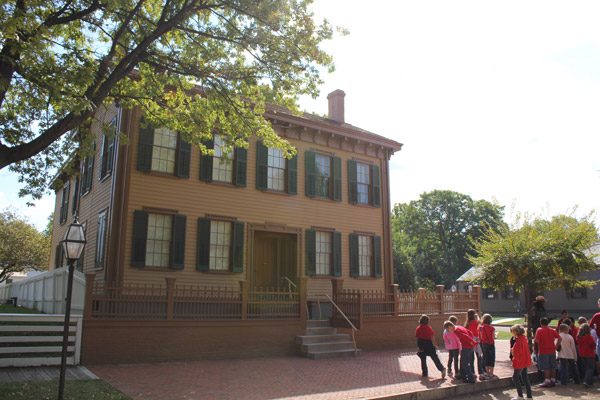
The National Park Service keeps this place in nice shape.
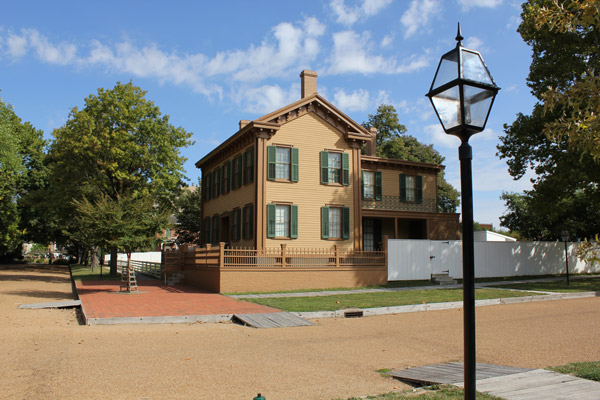
The lampost was imported from Narnia.
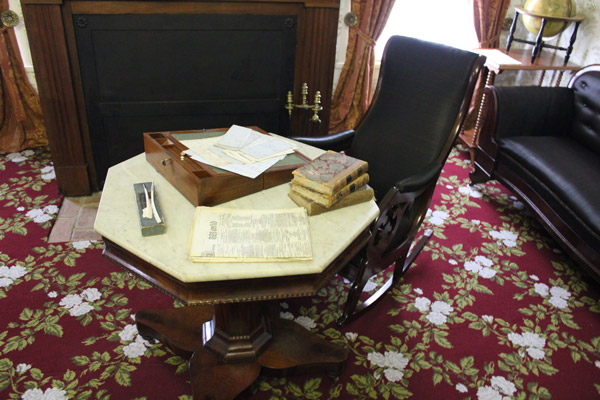
The back parlor, I think.
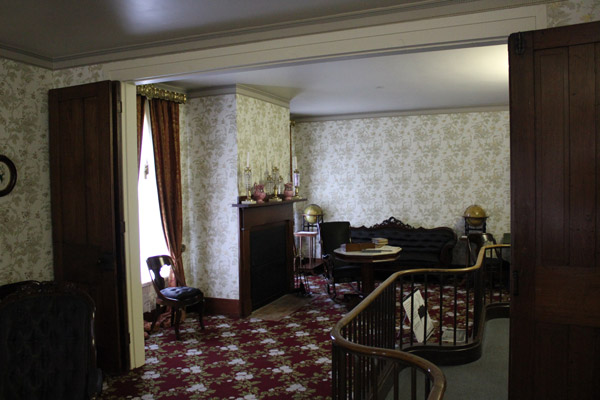
Where people would party with Abe and Mary.
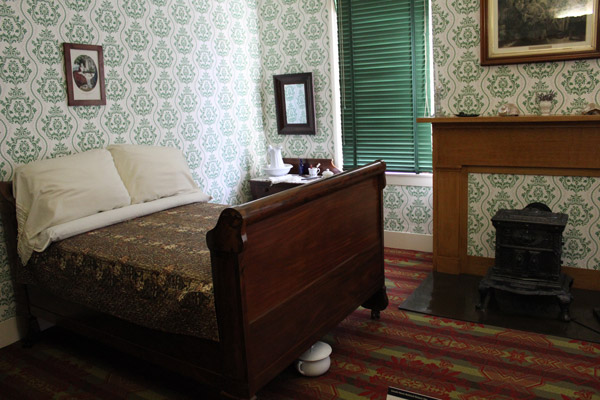
A less famous Lincoln Bedroom.
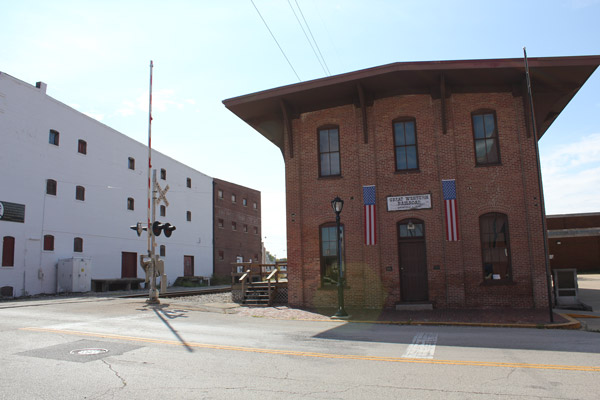
The Lincoln Depot: Say hello to Lincoln's goodbye to Springfield.
Lincoln needed a house in 1844, because life was going good. He had been living in Springfield for a few years, making a name for himself as an attorney; he had convinced Mary Todd to marry him; and their family was growing. Lincoln dropped $1,500 and snagged a one-level, five-room home on 8th and Jackson. It was the first (and only) home he ever owned. There was no indoor plumbing, but it had curb appeal, on the days when the curbs were covered in mud and pig crap. The prosperity train kept rolling, and after a few years they put a second story on the house (in two months, because union labor hadn't been invented yet), resulting in the building you see today.
It's in great shape, considering the abuse it takes each year from busloads of old cranky people who feel entitled to touch everything and bored school kids who touch everything out of spite. There's a pretty nice front parlor for unwanted guests, and an attached rear parlor for the people they actually wanted to see. Abe was sitting in the front room when he got the news that he had become the GOP nominee in 1860, and there was much rejoicing. A surprising amount of the stuff in the house is original: when they left for D.C. in 1860, the Lincolns decided to rent out the joint rather than sell, and before leaving they opted to sell most of their stuff in a yard sale. After he was killed in 1865, a lot of the purchasers took very good care of their suddenly much more valuable bedpans and armchairs. Lincoln's box of old skin mags and erotic playing cards has yet to resurface, but historians are holding out hope.
The dining room and kitchen weren't big enough for lavish entertaining, though the Lincolns did have guests on a pretty regular basis. The sitting room had a stereoscope picture viewer for the kids -- an 1840s Xbox, according to the ranger -- and Lincoln would sometimes stretch out on the floor to read. At 6'4", he wasn't really comfortable in any of the horsehair furniture. But he did have one particular luxury, on the second floor.
That would be Mary Todd's separate bedroom, which is a tremendous feature when you're a depressed person married to a bipolar nutjob. They dance around Mary a little bit at the house -- no one wanted to condemn the woman, but there wasn't exactly an energetic defense. There are a few undisputed facts: 1) Mary came from a high-class family was clearly interested in social climbing; 2) Mary and Abe did have some affection for each other and had sex at least four times; 3) Abe spent a conspicuous amount of time outside the house; 4) Mary had a hired servant to do her bidding, and they went through an average of a servant a year. Lincoln had to propose twice, since she broke off their first engagement.
Anyhow, it's a very nice upper-middle-class home. At the height of his legal career, Lincoln was raking in the dough and had the modern-day equivalent of maybe $500,000 in the bank. The walls and floors all have vomit-inducing patterns, which was very stylish back in the 1840s. The park rangers sell the house of the eye of the storm: after a rough-and-tumble youth, but before he was shot in the head, there was a decade when Lincoln was free to prosper and grow as a professional and a family man. He advanced his career, he shipped one son off to college, he welcomed new kids and enjoyed his friendships all in the house. There was sadness, too -- his son Eddie was born in the house in 1846 and died there in 1849. But overall it seems like a postive time.
The neighborhood ain't bad, either -- the park service owns two blocks of 8th Street, and all the homes are preserved as they would have been during Lincoln's time. They know from letters that the Lincolns got on pretty well with the neighbors, and when he split town for the White House, he gave an emotional goodbye at the "Lincoln Depot," about two blocks away. Before hopping on the train, he gave a short farewell that generations of Springfield public school students have undoubtedly been forced to memorize, minus the awkward dirty limerick at the end. Today it serves no real purpose, but Lincoln once spoke there for 60 seconds, so the building is in great shape.
The Lincoln Lawyer
Some say Abe Lincoln was a bone golem, animated in 1860 by the Illuminati in a sinister attempt to maintain their dominance of the military-industrial complex. Experts such as myself know he was a lawyer. It's a subtle difference, but a difference nonetheless.
Abe had four different offices during his years in Springfield. Three of those buildings are gone, but the one remaining structure is now (surprise!) a museum. There's not a ton of original Lincoln swag left in the building, but they do a nice job of laying out his legal career:
It's the 1830s. Twentysomething Lincoln has been toiling his whole life, and is probably a little sick of professions that involve regular exposure to animal waste products; after a stint in the state legislature, he starts to feel a little self-conscious about his lack of legal knowledge. A voracious reader, he consumes enough information over the next three years to be considered a lawyer by Illinois standards.
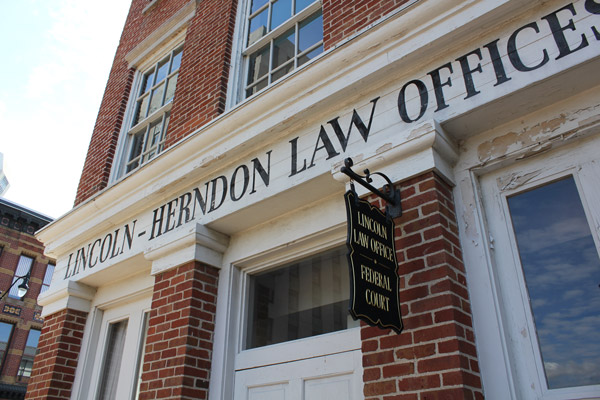
A very well hung shingle.
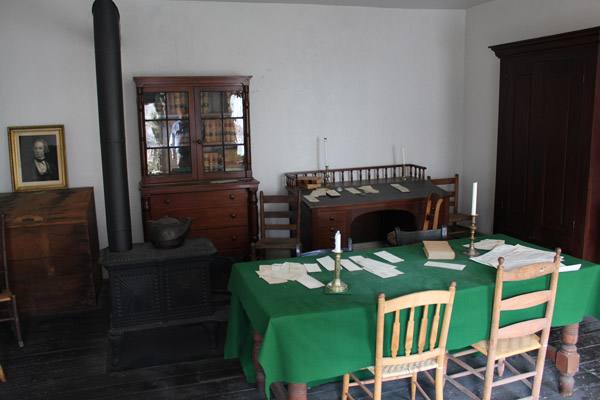
Historians' best guess at the organized chaos of Lincoln's law office.
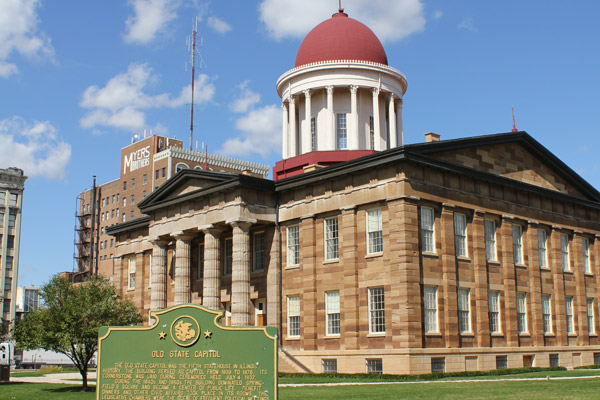
The still new-looking Old State Capitol.
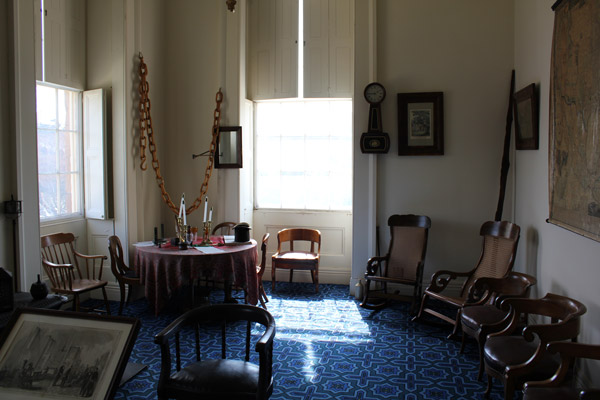
Offices in the Old State Capitol.
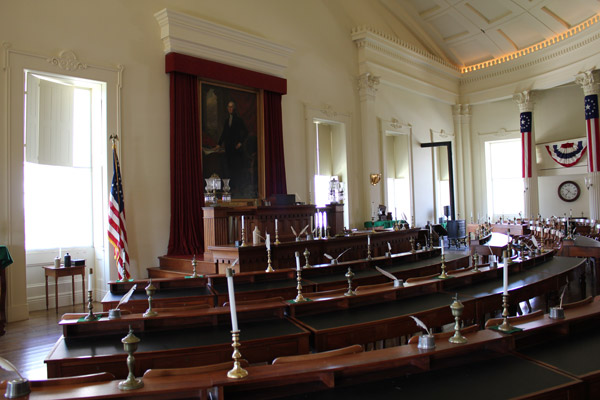
A re-creation of Abe's old stomping grounds at the Old State Capitol.
Abe lands a job in Springfield, and moves into that prairie town as a junior partner. He works on every kind of case, from civil litigation to captial punishment cases. The state code could be printed on a placemat back then, so you didn't need to be a specialist. He goes through a couple of partners before settling down with William Herndon, who will be his partner through his death (and afterward, his biographer).
Lincoln goes for the big bucks by "riding the circuit" -- since there was one federal judge for all of Illinois, he had to travel from county to county on the back of a burro, dispensing justice and leaving a trail of judicious babies. The lawyers travel as well, so Lincoln was away from home for two to three months at a time. This is beneficial financially. It is very beneficial politically -- it gives Lincoln a chance to meet power players throughout Illinois. It is extremely beneficial in the marital sense, because three months away from Mary is a good thing.
And it turns out he's a decent lawyer. Herndon was the paperwork guy, and Lincoln was the talker. He knew how to work a jury, and he also scores lucrative gigs working for the railroads.
The law office, like everything else in frontier Illinois, doesn't reflect the level of success. It was above a dry goods store, which was next to a farmer's market -- as the guide put it, the 19th-century equivalent of a Super Walmart. You could walk up without an appointment, and Lincoln would hear you out while stretching out on couch. The place was probably a mess. Lincoln was a bit of a slob, and some days his young sons would be jumping on the desk. Professional stuff.
There's something to be said for the location. The feds rented space for the circuit court right next door. And the law library for the state (four books and pamphlet, in the 1840s) was housed across the street at what's now called the Old State Capitol building. The exterior is close to original, but the interior is a re-creation, because the insides smelled too much like frontier justice. Lincoln served here his last term in the state legislature. He ran his 1860 presidential campaign out of the governor's office (the governor had died, so it was totally cool). He gave the "house divided" speech in this building. When Lincoln left town for Washington, he told Herndon to keep his name on the sign, so that he could rejoin his partner when he was done leading the country. The closest he got to returning to the office was the Old Capitol, where his corpse laid in state.
The state upgraded somewhere along the line, and the legislature now meets in a fine structure just a few blocks away.
It's a mildly historically significant building, in that many a fine corrupt Illinois governor kept offices here. Rod Blagojevich? You know it. George Ryan? Of course! The Illinois legislature also meets here, and the Senate chamber is sort of intriguing. Another Illinois lawyer with no executive experience once served in that chamber, and like Lincoln, he went on to be president. Guess which one. Go on, guess.
The Oak Ridge Boy
Lincoln's death was a wee bit unexpected. The country did manage to throw together a U.S. funeral tour in short order: 1,700 miles by train back to Springfield, with stops for funeral services and body-viewings along the way. Unfortunately, that bought only three weeks of time, so when they got to Oak Ridge Cemetery the remains were deposited in a stopgap resting hole.
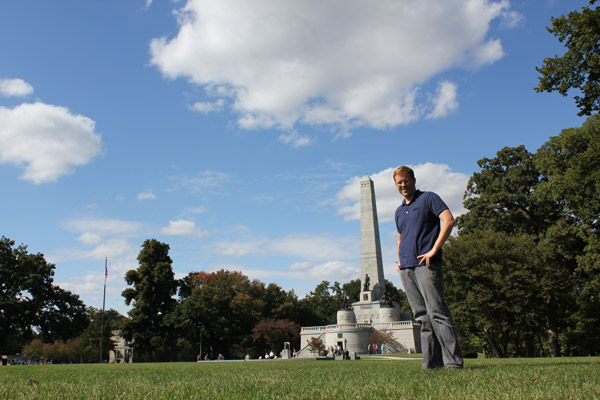
Abe's final resting place.
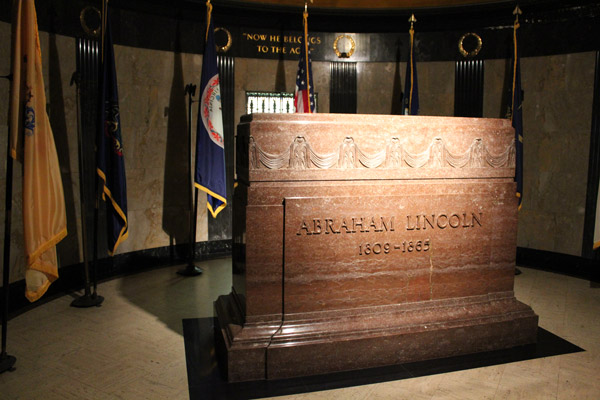
The very fine Arkansas granite marker inside the tomb.
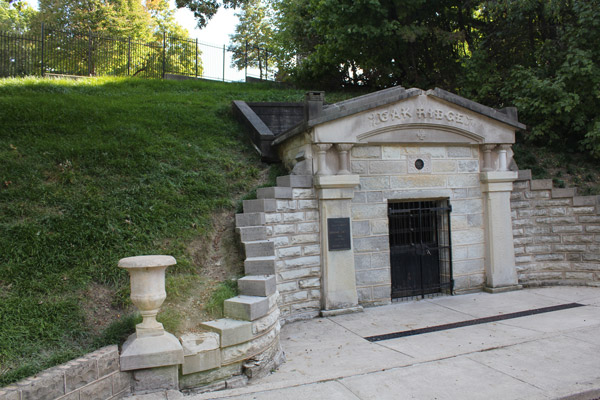
The original (temporary) burial vault.
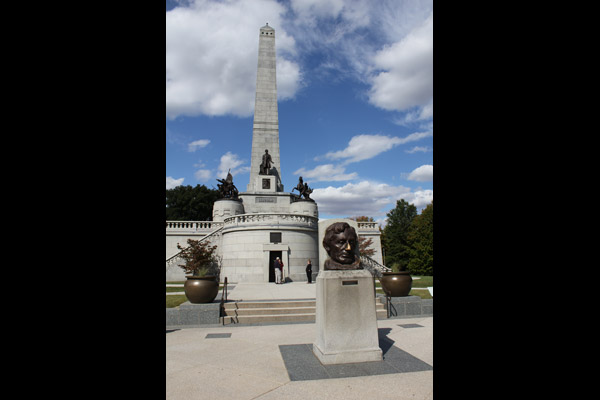
A wide vertical shot of the tomb's exterior.
That's Oak Ridge's "public vault," and it's the first semi-official resting place for Lincoln's bones. The number of visitors was stunning, and after a few months the remains were removed to a temporary tomb in the side of nearby hill. They rested there for a few years, but the number of visitors was still stunning, so once construction was partially complete, they were shifted over to another structure.
It's actually less grand than Grant's Tomb, Garfield's Tomb, or McKinley's Tomb, but it is 117 feet of somber awesomeness. You can't go wrong with a distressingly phallic obelisk, and the four statues surrounding Lincoln represent the four services he commanded in the war (army, navy, artillery, cavalry). The Lincoln statue is holding a copy of the Emancipation Proclamation, and a plaque bearing the Gettysburg Address is hanging over the entrance to the base. Sometimes, you get the impression that they made about 10,000 such plaques, and they just needed excuses to unload the things.
As for what's in the base? Until 1931, all you could do was walk in, see a tiny rotunda with a small exhibit on Abe and leave. Today, you get a more personal experience. A marble hallway hallway winds you past a few Lincoln statues. It's dim and sterile, and the drab color scheme has the feel of a 1950s federal building. But suddenly, you're face to face with the big guy.
Actually, "face to face" isn't accurate. Lincoln is 10 feet below that slab of Arkansas granite. Grave robbers had attempted to take Lincoln's remains in 1876 and hold them ransom. So when the whole burial site was renovated around 1900, son Robert insisted on making the remains untouchable. Lincoln was put in a metal cage, which was then encased in concrete and sunk well below the surface. Mary is in the wall behind him, as are sons Eddie, Tad and William. Only Robert is missing from the family reunion; he's in Arlington National Cemetery.
I lucked out and squeezed into the room ahead of a tour bus with about 68 senior citizens, so I was relatively close to alone. What's striking is the simplicity of the marker; once you're in the burial chamber, it's easy to block out the monument around you and just focus on Abe. The slab dominates the room, with its size and simplicity. It sounds corny, but you can feel its gravity. Lincoln came from nothing, but he somehow managed to cut through the knots that had bound the country since its founding. He was handed an impossible situation and handed back a country finally ready to ascend to greatness.
There's so much fuss over Lincoln that it's easy for a natural cynic to dismiss him. That's harder to do when you've seen him.
New Salem
There's historic Lincoln, and then there's legendary Lincoln: the one who split a rail made from a cherry tree, threw a $50 bill across the Sangamon River and wrestled a bear to become the king of Illinois. A lot of the legend comes from New Salem.
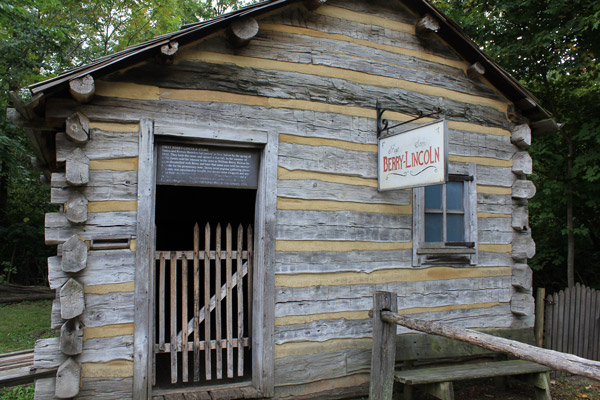
New Salem: Lincoln be shoppin'.
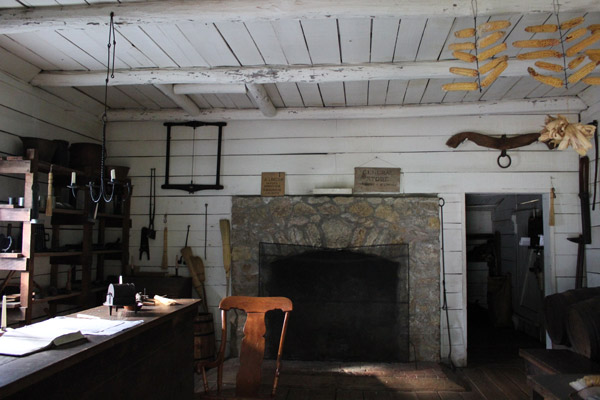
New Salem: What's in store.
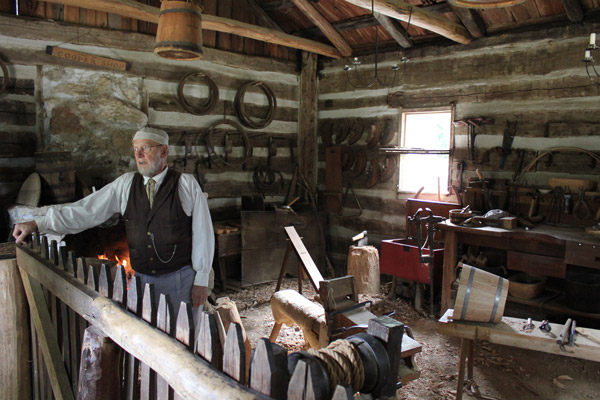
Hangin' with Mr. Cooper.
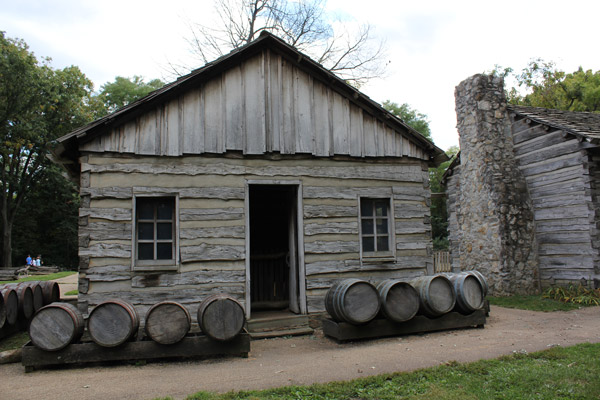
Hangin' with Mr. Cooper.
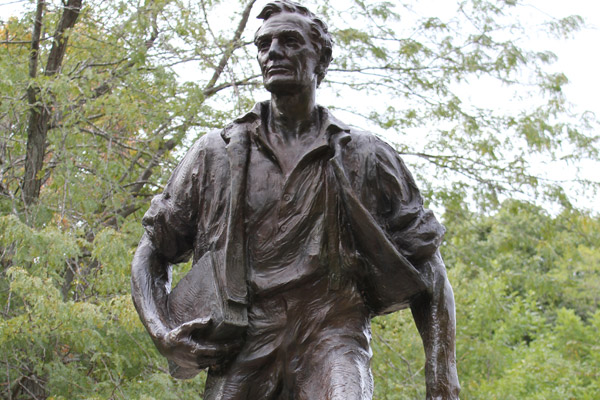
The iconic Lincoln image, courtesy of New Salem.
Some back story: Lincoln and his dad didn't get along. Young adulthood in Indiana wasn't all that fun; there was lots drudgery as the family tried to hack a living out of the middle of a dense forest. Sometimes Thomas would pimp his son out as a laborer and keep most of the money. The only real relief from the drudgery was reading, and the occassional arts and crafts project, like making his mother's coffin.
The family moved to Illiniois when Lincoln was 21, but Abe had enough. He set out on his own and never saw his dad again. One of his first jobs was for a man named Denton Offutt, who hired Abe to take a flatboat loaded with cargo to New Orleans. Floating down the Sangamon River, the flatboat got stuck on the dam for a sawmill; during the unexpected stop, Offutt was impressed enough by the newly founded nearby town that he decided to open a shop there. He was impressed enough by Lincoln to bring him on as shopkeeper.
For the next six years, Lincoln was the lovable, goofy handyman in the sitcom that was New Salem. He had a lot of jobs, since the original store ended up being a bust: rail splitter, shop owner, children's birthday party clown, farm worker. He also snagged part-time government work as the postmaster and, interestingly enough, the local surveyor -- the same job that got George Washington off the ground. He had his brief stint with military service in New Salem, as a militia captain in the Black Hawk War (no hostile Indians encountered). And he was popular enough to get elected to the state Assembly.
But mostly, he read. To become a lawyer in the 1830s, you didn't have to borrow $100,000, then live with your parents for three years while searching for a $35,000 job that requires 60-hour work weeks. All you had to do was study really hard and take a test. That's how Lincln spent his spare time, and after a few years of folksy suburban toiling, he was ready to move to the big city of Springfield as a full-fledged lawyer.
Unfortunately, Lincoln was the linchpin of the New Salem economy, and a few years after his departure the town disappeared. (Also, they found out that steamboats couldn't navigate the Sangamon, so that didn't help.) What you're visiting today is couresy of William Randloph Hearst -- Citizen Kane -- who snagged the property early in the 20th century. In the 1930s the CCC started building some replica structures, and over time they've got it up to a 23-building "living history" village. I got there late in the day, so only the cooper was on duty. But there's nothing more exciting than buckets.
FUN NEW SALEM FACTS!
- Lincoln is the only president to hold a patent, and it is for a method to get a stuck boat over a sandbar. Historians believe this is tied directly to his desire never to get stuck in a craphole like New Salem again.
- New Salem was the site of Lincoln's famous "wrestling match," when someone bet the newcomer he couldn't take down one of the town ruffians. Depending on the eyewitness, Lincoln either won, lost cleanly, or lost when the other guy cheated. Everyone agrees, however, that Lincoln won the respect of all the drunken losers in town.
- Lincoln had no "home" in New Salem, instead sleeping in his shops, renting rooms from townspeople or crashing in a lean-to known as "Abe's Love Emporium."
- Lincoln allegedly had at least one romance while in New Salem, with Ann Rutledge. It's possible the stories were trumped up, however, to justify five chapters of sex scenes in early versions of Lincoln biographies.
What Danny Glover Said
Any visitor to Saint Louis should definitely check out the National Monument to the Blown ACL. They also call it the City Museum.
The word "museum" in the title is a bit of a stretch; it's more like a public space designed by people with access to religious-grade peyote, who were supervised by people using lots of inhalants. In fact, the only drug not associated with the City Museum is ritalin, because it's a great place for kids to go insane.
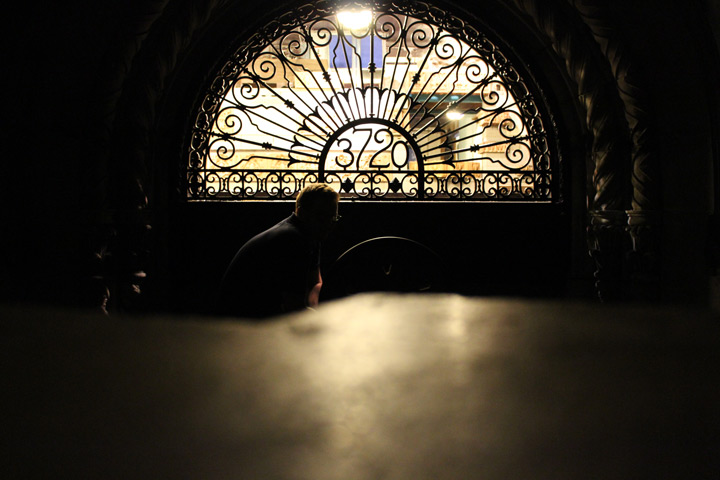
Inside St. Louis's very trippy (and fun) City Museum.

Inside St. Louis's very trippy (and fun) City Museum.
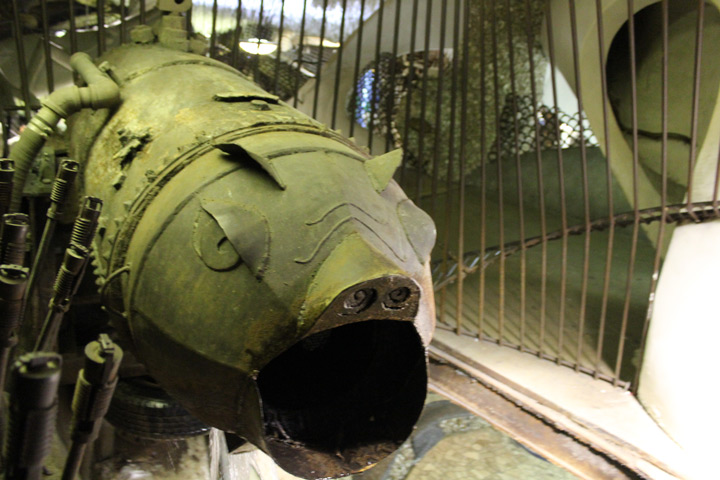
Inside St. Louis's very trippy (and fun) City Museum.
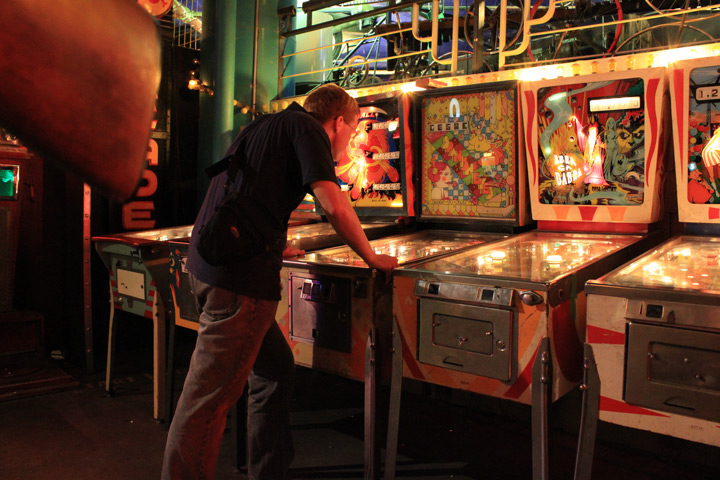
Inside St. Louis's very trippy (and fun) City Museum.

Inside St. Louis's very trippy (and fun) City Museum.
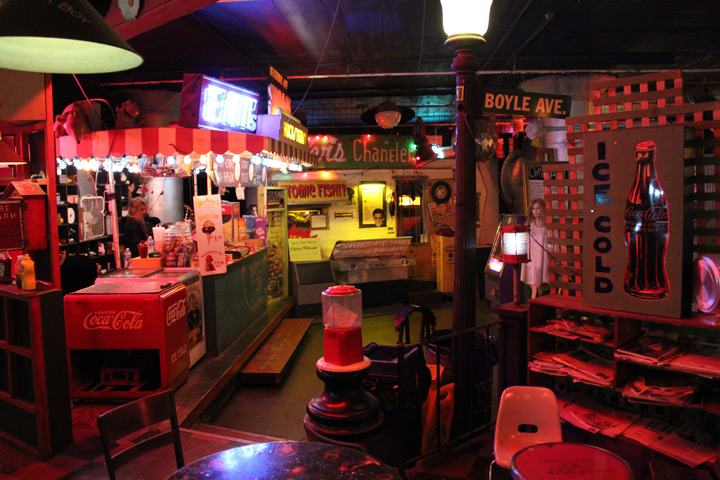
Inside St. Louis's very trippy (and fun) City Museum.
Or adults, for that matter. I went at 9:30 on a Friday night (it's open until 1 a.m. on the weekends) and had my mind blown. The museum is divided into a few major areas:
- The aquatic treehouse cave space. This is a multi-level series of passages, tunnels, metal baskets and slides, decorated to look like a giant treehouse that bleeds into an aquatic area where you can walk out the throat of a giant fiberglass whale who seems to be embracing some sort of squid thing underneath a ceiling of white plastic tendrils. It also has a big tank with live turtles.
- The 10-story spiral slide. This is a mostly vertical space. The basement area is a series of passages, tunnels, metal baskets and slides designed to look like a cavern inhabited by dinosaurs and carvings of topless women; above that is a series of spiral staircases ascending through a chamber that looks like something from Fritz Lang's "Metropolis" but with a pipe organ. At the top is a spiral slide that could potentially make you vomit.
- The roof. This features a rope swing, set in the middle of what appears to be Thunderdome; a very fast Ferris wheel that could potentially make you vomit; a long metal slide descending from an enormous praying mantis statue down to the rooftop; a large ramp to run up; a school bus hanging over the edge of the building; and a bar.
- The parkour room, video arcade, coffee shop and building ornamentation wing. This has a room where people can practice the economically viable art of freewalking, a freak-show themed coffee shop with vintage pinball machines, and an actual museum display of old carvings from buildings, only the lights are off in most of it so it seems haunted. There is also a Bob's Big Boy statue.
- The outdoor playground. Featuring ball pits; two small aircraft mounted on towers, accessible by a series of narrow metal-mesh tunnels which allow to crawl 40 feet above the ground; and a series of passages, tunnels, metal baskets and slides.
- The gift shop.
It's pretty fun! And also depressing! It's not tough to crawl uphill through a narrow metal cage / tunnel, but getting my feet in front of my hips for the descent almost destroyed every ligament and tendon in my legs. I'm choosing to believe it's because I'm 6'1" and not because I'm 34.
September 24, 2011
The action has now moved entirely to the city of St. Louis. Gateway to the West! Depot of destiny! Economically depressed with too much suburban sprawl to make for a compelling downtown!
A House Divided
In September 1843, Ulysses Grant reported to Jefferson Barracks, right outside St. Louis. He had graduated from West Point in the middle of his class, and inspired by the frontier spirit of his new home, he was blazing a glorious path to the very center of mediocrity.
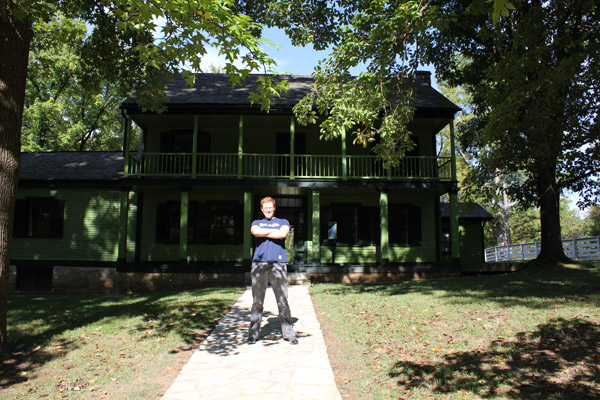
White Haven: The home of Colonel Frederick Dent, father-in-law to the stars.
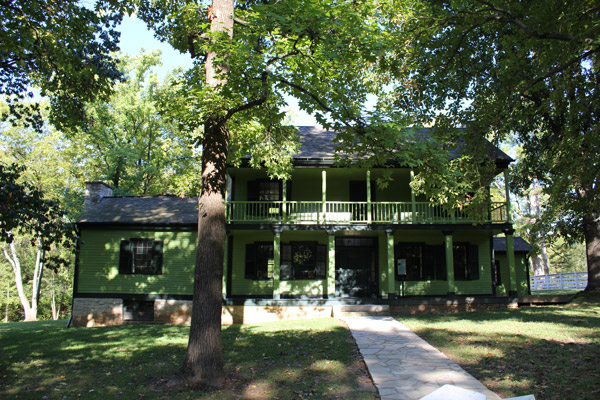
White Haven: Grant eventually took control of his FIL's property, 'cuz he was good at sieges.
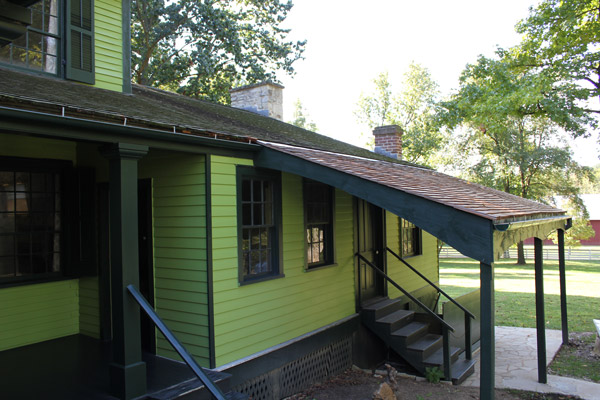
White Haven: Another exterior view. Trust me, there's nothing to see inside.
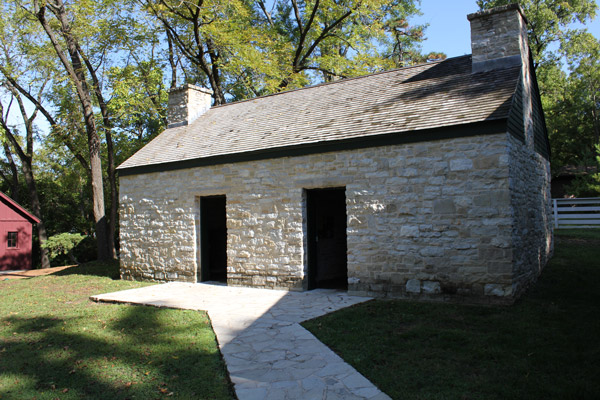
White Haven: One of the outbuildings at the farm.
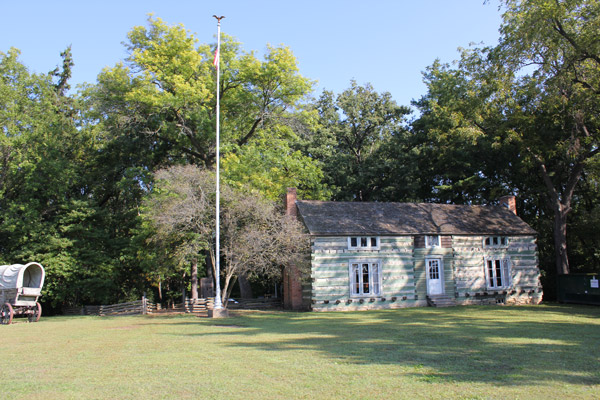
Hardscrabble: The house that Grant built, now owned by Budweiser.

Animal buddies at "Grant's Farm," a family spot run by a beer company.
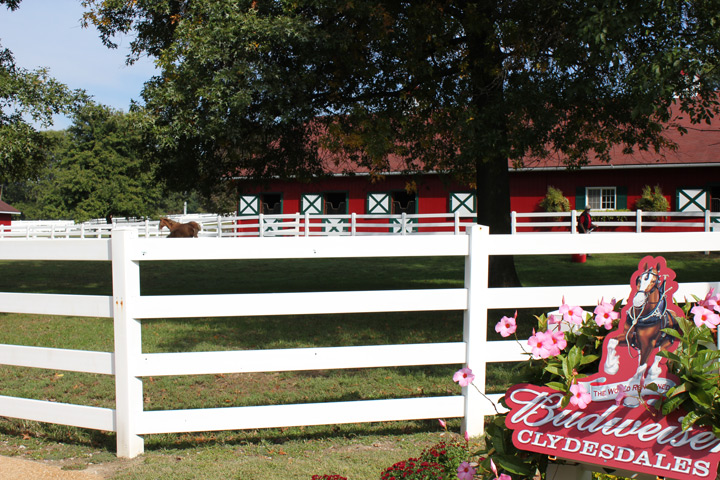
At Grant's Farm, the home of the famous clydesdales.
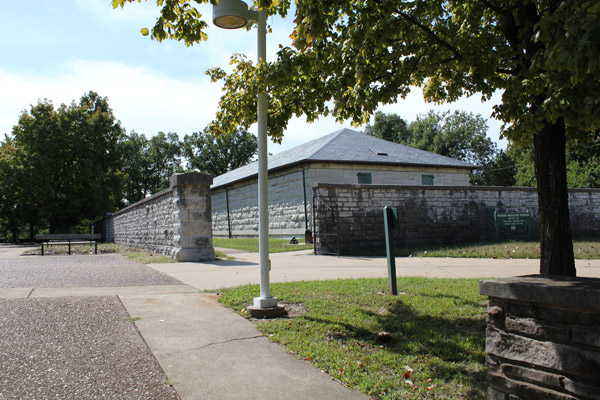
Jefferson Barracks: A peek at the park now on the barracks grounds.
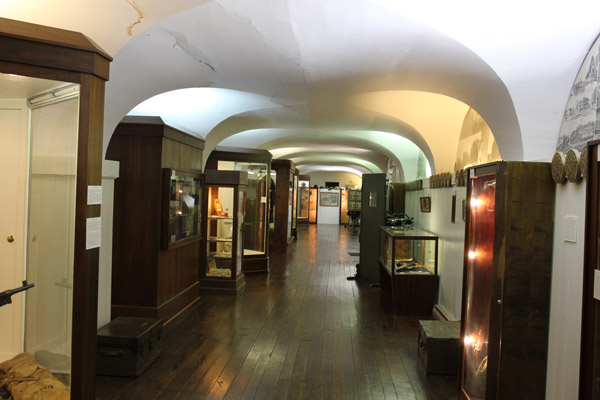
Jefferson Barracks: Inside the barracks museum, a converted powder house.
Actually, a lot of journeys started at Jefferson. It was one of the military's most important training and mustering sites from the early 19th century up to 1946 -- Robert E. Lee once commanded the post, and Zachary Taylor did a few stints alongside the Mississippi, and my grandfather did his basic training there in WWII. Today, it's been divided up into a National Guard base, a veterans cemetery, some private housing developments and open fields. A few old powder houses have been converted to museums staffed by very courteous senior citizens. There was a cross-country meet going on when I came to visit, and I think generations of soldiers would be thrilled to know that high school guys in short shorts were cavorting over the same parade grounds where they once froze their nuts off.
For it gets cold on the Mississippi River. My grandfather has stories about overcoats getting so frozen they stood up on their own. Fortunately, Grant's West Point roommate was also at Jefferson, and happened to be from the St. Louis area. So there was always a chance of a homecooked meal, just a muddy horse ride away.
Grant got this at White Haven, the home of Colonel Frederick Dent, who made his money in fur trading (that's not a euphemism). The house is pretty much a glorified log cabin; the main building is mostly vertical timbers plastered over and painted.
As for Fred, he's basically a Tennessee Williams character -- a domineering, patriarchal plantation owner who wasn't actually a colonel, but insisted on the title. He was a racist and a slave owner, and he liked to be the big shot: he had so many visitors, he painted his front door orange to make it easier for guests to find him from the main road. As the slavery issue started to divide the nation, his home was becoming an island of southern sentiment in a mostly anti-slavery town.
And of course, he had a hot daughter. Well, hot by 19th century standards. At least to Grant.
When presented with a plantation owner's daughter, you pretty much have to hit on her, so Grant obliged. According to the great park ranger who gave me the tour, Julia wasn't exactly receptive. Grant went with the "Steve Urkel" approach (the ranger's words) and wore her down. It didn't sound particularly hot and heavy: horse rides, reading book aloud to each other, and the Colonel chaperoning every meeting for a year. Then, to play hard to get, Grant left to fight in the Mexican-American War.
There's nothing like being shot at by Mexicans to galvanize a love affair, and they were married when he came back. The Colonel, thinking Grant a shiftless loser and did not particularly like him, decided that the only proper thing was for U.S. to move into White Haven, where he could be brainwashed into becoming a Southerner. Grant, realizing the tacit contract when you marry money, obliged. He got a nice chunk of land for his trouble, and after a time he also got a slave from his father-in-law.
To be fair, Grant made some effort to be his own man. When life gives you slaves, make lemonade, or at the very least a terrible cabin. "Hardscrabble" was built on Grant's parcel of land by Grant and William Jones (who was freed in 1859). He and Julia lived in that craphole for about four months. Then Julia's mother died, and Julia insisted that they move back in with dad. Hardscrabble is actually not in its original location; it was moved around a bit and used as a coffee shop in the 1904 World's Fair in St. Louis. The Anheuser-Busch family bought Grant's old farm as their country estate, and eventually moved the cabin to a new spot on the property. The estate (right next door to the National Park site) is now operated as "Grant's Farm," which combines a child-friendly zoo and safari park with an adult-friendly beer garden. For just $11, you can ride on a tram past Hardscrabble at 5 mph and never get within 50 feet of the building. But then you get to pet a goat, so ... I guess that makes it worth it?
But back to White Haven. A funny thing happened in the 1850s: Grant ended up taking over the family. The plantation wasn't exactly lucrative, and as anti-slavery sentiment started to spread, the Colonel found himself a social pariah. The Colonel kept reducing his slave holdings and renting out parcels of his land. Grant was scuffling himself, but he ended up slowly acquiring more of the property from his father-in-law. At the start of the war, the Colonel urged Grant to get on board with the Confederacy, but Grant (obviously) declined. The Colonel eventually came to live with Ulysses and Julia in the White House, which had to be as big a plate of crow as any parent ever swallowed.
The X factor in all this is Julia. According to my guide, she was living in the clouds; she enjoyed the perks of plantation living, never really gave much thought to the morality of slavery and focused on her perfect devotion to her father, husband and children (three of Grant's four kids were born at White Haven). They have a pretty nice museum in the old barn, detailing a marriage that included some long separations and sincere lovin'. Grant married a flake, but she was a flake with a good heart.
The house today is empty. The Grants rented it out when they left town for military and political pursuits, and when they did so they decided to store all the furniture in the nearby home of a relative. That home mysteriously burned to the ground in the middle of the day -- it might have been arson by abolitionists cheesed at the Colonel -- taking all the original furnishings with it. And the Grants never has a reason to refill the home, as they didn't retire to St. Louis; Grant eventually had to sell his wife's ancestral home to cover family debts.
FUN GRANT FACTS!
- Grant was wary of booze, which he felt either knocked him on his ass or had no effect. But Grant's reputation as a drunk lingers, mainly because he refused to defend himself in public, and also because Budweiser operates his property as a theme park.
- When in Mexico, Grant would send letters to Julia written on any convenient surface, including drumheads captured from the Mexican army and receipts from suspicious cross-border pharmacies.
- Grant was famed for directly and relentlessly attacking his opponents until they were exhausted. He perfected this strategy trying to get to second base with Julia.
Arch Angel
Saint Louis was once a mighty lens, focusing the energy of a youthful nation into a beam of industry. Reachable by land, accessible by steamboat and centrally located, it was the gateway to opportunity for anyone with determination and a dream. But then the railroads got big enough to circumvent the city, everyone sprawled out to the suburbs and the downtown became an economic sinkhole. We remember that collapse today with a mighty arch.
To build the Gateway Arch, they had to demolish the orignial town. Blocks and blocks of waterfront property, much of it abandoned and decaying amid the city's economic funk, were eradicated to make the space required for Eero Saarinen's monument to western expansion. Irony is usually a dead-end street, but in this case, it worked out beautifully.
Eero won a design contest in the 1940s, thanks to one huge advantage: he had no idea how to build his stunning design. Some engineers picked up the slack, and a mere 18 years later (1965), the final segment of the Arch was installed. Eero was dead by that point, but he probably would have enjoyed the finished product. It's 630 feet high (you could fit the Washington Monument under it), the stainless steel gleams in the sun and generations of a-holes have been inspired to scratch their names on the bases of the legs.
My visit on Saturday was actually my second trip there. The summer after I finished 6th grade, my family went on a "Vacation" vacation, with the five of us packed in a mini-van and driving as far west as Idaho. There wasn't a dead woman strapped to our roof, but We still had a good time, including our stop in Saint Louis. I remember going up to the top of the arch inside those claustrophobic little pods.
That's why I didn't feel so bad about staying on the ground this time. I flinched at the airport-style security when I got there around 1, and when I came back around 4, all the tickets for the tram were sold out for the day. Plus, they've kind of stunk up the view. If you look east, you're staring at a casino in Illinois. If you look west, a lot of the vistas are now gummed up by companies that just HAD to put a tall building near the arch. Whoever signed the building permits should be shot in the face.
[DC analog -- they build the baseball stadium to have a view of the Capitol from the upper deck, and then Booz Allen Hamilton puts an office directly in the sightlines. JERKS.]
I did go in and enjoy the museum of westward expansion, underneath the ground at the middle of the arch. It's a little short on artifacts, but it does have a stuffed bear and a nice chronology of the Lewis and Clark expedition, which really got rolling near Saint Louis. I also took in the other main historical attraction.

All arch, no nemesis.
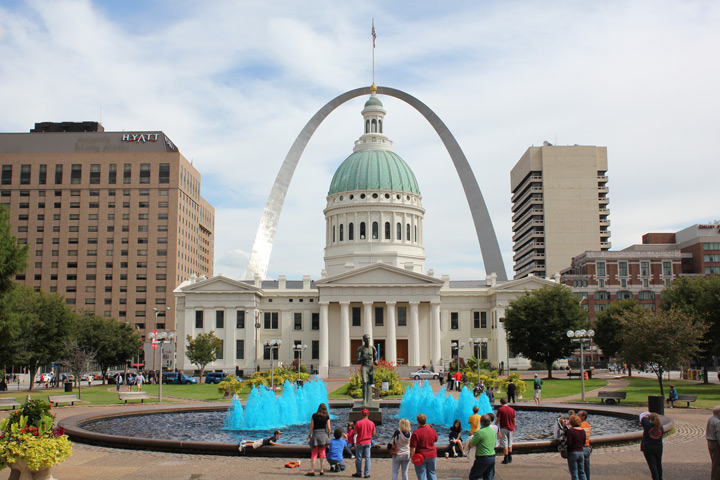
The Gateway Arch and the Old Courthouse, St. Louis' most famous vista.
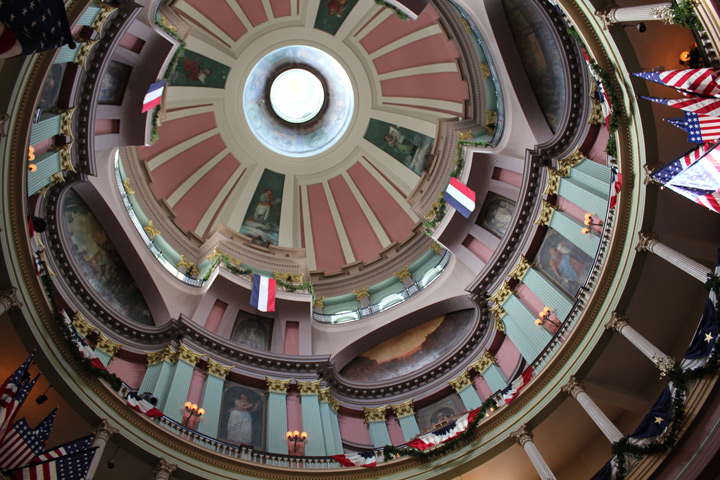
An interior shot of the Old Courthouse dome.
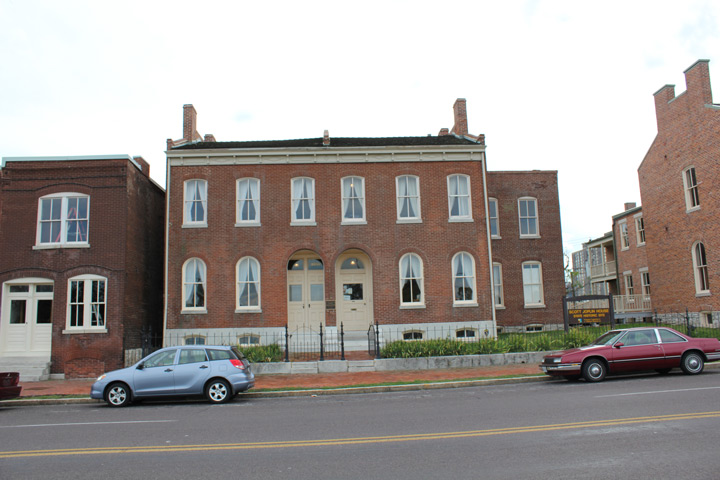
Ragtime? More like raggedy time. Scott Joplin's onetime home.
That's the Old Courthouse, which would have been the center of all kinds of public activity going back something like 150 years. It's also where the Dred Scott case got its first hearing. Dred was a slave whose master had taken him for awhile to "free" states; he sued for his freedom on the understanding that long-term residence in a free state gave him his liberty. It took a decade for the case to move forward, and in that time Dred was almost the property of the state -- the sheriff could farm him out to local businesses and hold on to his wages as his legal status was determined. The Supreme Court in 1857 eventually came down on the side of the slaveowner, ruling that Scott was property and had no standing to sue in the first place; disgust over that ruling helped destroy any chance of avoiding a civil war. Scott at least had a (sort of) happy ending, as he was sold back to a master who freed him; he then died the next year.
After that, I strapped on my spats and strolled around downtown, which is kinda sorta dead. They have a football and a baseball stadium, plus lots of office buildings, but you get the impression that it's a ghost town on nights or weekends when the teams aren't around. I took the extra special walking tour, in my quest to find the Scott Joplin house. I know the street name, but I forgot the number, so I just started walking west. It turns out that downtown transitions pretty quicky to bombed-out industrial, and I was just about to turn around when the Joplin house appeared.
It was maybe the most disappointing historical site I've been to. Scott Joplin was a beast, musically. Ragtime was one of the forerunners of jazz, and Joplin was one of the great black composers. I had high hopes. But he only rented an apartment in the house for two years, nothing in the apartment is original, most of the building has been rebuilt, the old neighborhood has essentially been demolished, it's unclear what work Joplin completed in the house, and the staff was sluggish.
Oh, and I found out that Joplin died from syphilis.
I needed a drink after that mess, so I got in the car and headed over to Soulard. It's a historic neighborhood, with a historic farmer's market. I skipped that market, because I have external genitals. Also, Motel 6 has no refrigerators in the rooms, so delightful local produce is not going to be as tenable as the peanutbutter sandwiches I usually eat alone in my rental car.
It's a neat, quirky little place, though. Lots of corner bars and live music and drunk people. I hung out at 1860's, which was a dump. But they had a really good roast beef sandwich and a band playing the soul hits of the 1970s, so I was happy to be there.
September 25, 2011
All good things come to an end, and Nerdcation went out with a bang.
Baseball Heaven
I went to old Busch Stadium when I was a kid. My dad took me, and we saw the Cardinals play the Expos. I remember Vince Coleman led off for the Cardinals, and the stadium was a lot like Veterans Stadium: dumpy.
They knocked down my childhood memories back in 2006 and replaced them with new Busch Stadium, so on the last day of Nerdcation I checked out the new digs. Check it out.
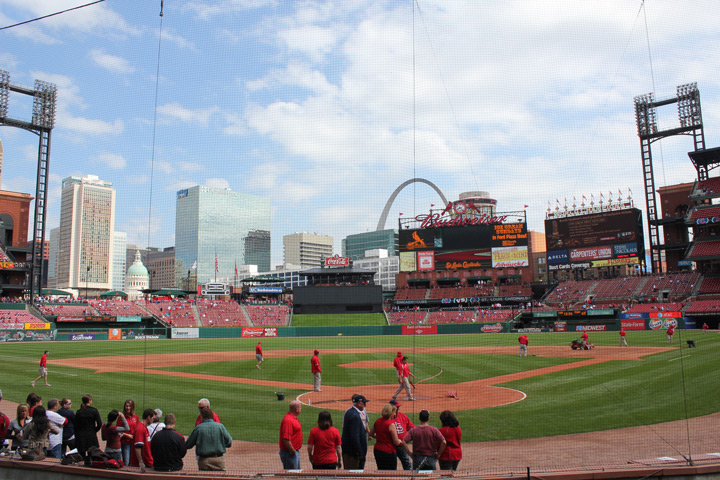
A nice home for one of baseball's great teams. It pains me to admit it.

This was actually Albert Pujols' last home came as a Cardinal.

The final resting place of Clark. Of Lewis and Clark fame.

Pennies for your thoughts. The grave of Dred Scott, who died a free man.
It's pretty nice. I was there for the last home game of the regular season, so the Cardinals were fighting for their playoff lives. Their opponent was the always entertaining (to opposition fans) Chicago Cubs, and the fans weren't sure if they'd ever see Albert Pujols playing in a Cardinals uniform again. Cards won 3-2 after late-inning homers, including one by the withered husk that was once Rafael Furcal. My report card for the day:
Architechure: B plus. The building is all red brick and cast iron, which actually matches the style of St. Louis architecture. It's not glamorous, but it's nice to see some awareness of history.
Food: C. I'm not a BBQ guy, so I missed out on that. But they didn't really seem to have a "signature" food item. The hot dogs were really good, but that was about the extent of the sausage-based comestibles. Not a bad beer selection, considering they're heavy on the Bud products. But overall, it was a bit of a disappointment. There was a full-service Hardees on the upper deck, but you have to be on the mood for a Monster Thickburger.
History: F. The Cardinals won the World Series 10 times. They have lots of Hall of Famers. They mostly acknowledge this with those really ugly statues outside the stadium, in which all the great Cardinals appear to have severe eczema. I know that they aren't commissioning world-class sculptors for ballpark statues, but they are almost universally hideous. The stuff at Nats Stadium is grotesque, for example. THe only park I've seen that really gets this right is Detroit.
Sightlines: B. The views of the city are really nice. You get the arch and parts of the Old Courthouse. The buildings of downtown St. Louis are generally squat and uninspiring, but of the parks I've been to, I'd put this view second to Pittsburgh. The problem is the concourse. A lot of the new parks, you can walk around the stadium concourse and have a great view of the field from most locations. That's not the case here. They really want to drive you to your seat. That's not the worst thing, but sometimes a guy wants to have a better view than the cheap seats he paid for.
Fans: A. Pujols got a standing ovation on his first at bat and appeared to wipe away a tear. No one seemed to leave early, most people wore red and folks were enthusiastic without being jerks. St. Louis has a reputation as a great baseball town, which they try to milk a little too much -- "best fans in baseball" was heard about 50 times before the end of the game -- but it's definitely a solid bunch. For the national anthem, they had the fans sing a capella. I really liked that.
That being said, the Cardinals will be crushed by the Phillies. Sorry.
The End of the Road
I didn't want to sit in an airport for four hours, and I have a strange sense of what's entertaining, so I closed out the Nerdcation with a stop at Calvary and Bellefontaine cemeteries. They are HUGE, and chock full of history. I did some speed touring and managed to see the graves of beer king Adolphus Busch, Gen. William Sherman, William Clark of "Lewis and Clark" fame and Sen. Thomas Hart Benton (the first senator from Missouri). Instead of boring you with all the details, I'll give you my personal highlight:
Dred Scott died a free man, and he was in a poorly marked grave for a long time. A few decades down the road, some people thought a nicer marker was in order, and they put up that simple stone. My favorite touch is the pennies -- Abraham Lincoln's face -- that people leave there as a tribute. Good way to finish the trip.
A Final Thought
If you have the time and money, take a nerdcation for yourself. It's worth it to indulge yourself every now and then. Just don't stay at Motel 6. I think I'm moving past that phase of my life. The one in Springfield was mediocre, and the one in Saint Louis was awful. The "non-smoking" room was apparently non-smoking because I don't smoke and I was sleeping there. It smelled like death. Their internet router was down for both days of my stay. When I came to the motel on Saturday night, three cop cars were outside the room next door, and three hipsters (two guys and a girl) were being questioned by cops. I don't know why they were being questioned. But I woke up at 7 a.m. when someone next door yelled "F--- YOU" as loud as humanly possible. Then a door slammed.
Good times.
